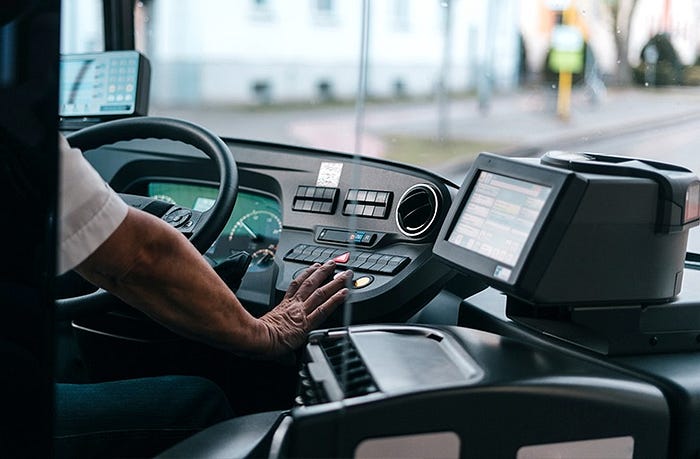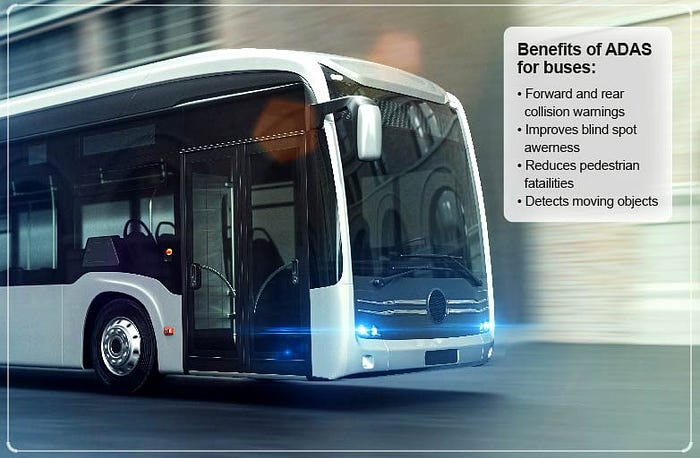Eliminating blind spots on buses and coaches

It’s tough for drivers of the largest vehicles to see everything around them, but the consequences of missing something can be devastating. As bus, coach, and truck fleets operate on increasingly crowded roads, drivers need help eliminating blind spots and highlighting potential collisions before they happen.
Happily, vehicles now have access to practical technologies designed to do just that. Let’s take a look at how advanced driver assistance systems (ADAS) can save costs for fleet operators and reduce accidents on the roads.
Driving Blind
It’s a cruel irony that the vehicles with the poorest visibility and are not only the most difficult ones to manoeuver, are but also the ones that can do the most damage in an accident. Even at walking speed, buses, coaches, and trucks can destroy street furniture and damage buildings. Where pedestrians or cyclists are involved, the results can be tragic.
Blind spots are a major cause of fatalities around the world. Research in the US estimates that each year, 267 people are killed and about 15,000 injured by ‘backover’ crashes alone — incidents where a driver simply can’t see someone behind them. In the US, some 50 children are backed over every week, with over 60% of cases involving a big vehicle such as a truck or SUV.
The largest vehicles such as buses and heavy goods vehicles (HGVs) have multiple blind spots. Crucially, other road users are typically unaware of the extent of these ‘no zones’, with many accidents happening when cyclists or pedestrians disappear from a driver’s view. A European study for the IRU — the global road transport industry association — found that these ‘unprotected’ groups constituted around a quarter of all those killed in HGV accidents. In the UK, a study of bus collisions for the municipal transport body Transport for London (TfL), found that obscured vision was by far the single biggest factor for drivers involved in fatal accidents. Failing to look and failing to see a pedestrian in a blind spot were considered common factors.

Investing in Safety
For fleet operators, their drivers, and of course any potential victims, the results of a serious accident can be harsh and long-lasting. Drivers face emotional and legal ramifications, while businesses may face repair and compensation costs, plus reputational damage that can impact on trading. But fleets can minimize their chances of being involved in a tragedy by equipping vehicles with the latest safety systems.
Newer buses, coaches and trucks are increasingly available with advanced driver assistance systems, which are designed to help drivers avoid easily preventable accidents. Forward collision warning (FCW) and autonomous emergency braking (AEB), for example, can help prevent frontal collisions or reduce their severity of by warning the driver and automatically applying the brakes.
Some advanced driver assistance systems also include Blind Spot Detection (BSD), which provides alerts to the driver when the presence of another vehicle, cyclist, or pedestrian is detected alongside them. BSD systems can also be supplemented with surround view systems (SVS) that offer a full 360° view of the vehicle and its immediate surroundings. If the BSD system presents an alert, the driver can quickly glance at the SVS system display and avoid any potential collision.
href=”https://brownbeat.net/wp-content/uploads/2019/08/Blind-Spot-enhanced-image-2.jpg”>

Proven Effectiveness
While the cost of deploying technologies such as ADAS and SVS in existing fleets can be significant, it’s reassuring to learn that multiple studies suggest that they do actually save lives. In 2018, a major review examined the potential for specific ADAS technologies to reduce road traffic accidents in the United States. Among nearly seven million crashes examined, it found that 29% may have been avoided by frontal warning and autonomous braking, while blind-spot warnings might have stopped 5% of accidents and prevented 89,000 injuries and 274 deaths.
Eliminating blind spots can also play a key role in reducing fatal collisions involving pedestrians and cyclists colliding with buses and coaches. The UK fleet operator association ACFO has called for fleets to fit ADAS technology to all vehicles, stressing that the technology also has a role to play in reducing the costs from damaged vehicles and from supporting the staff involved in accidents.
It’s easy to see why in 2019 there’s widespread agreement that technologies such as ADAS and SVS can vastly improve road safety, and save countless lives.
VIA Mobile360 ADAS technology is available in flexible configurations, and can be integrated with VIA Mobile360 SVS and other related technologies to meet specific deployment requirements. Configurations can be customized for a broad spectrum of applications in almost any environment — from buses and coaches on crowded city streets, to loading docks and construction sites.
Note: This article is part of a series of pieces about smart transportation trends that we have recently published on the VIA website. The content has been amended in places.
